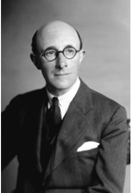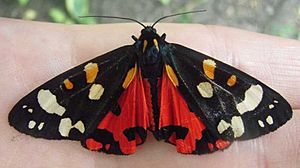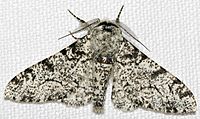E. B. Ford facts for kids
Quick facts for kids
Edmund Brisco "Henry" Ford
|
|
|---|---|
 |
|
| Born |
Edmund Brisco Ford
23 April 1901 Dalton-in-Furness, Lancashire, England
|
| Died | 2 January 1988 (aged 86) Oxford, Oxfordshire, English
|
| Alma mater | University of Oxford, (Wadham College) |
| Awards | Darwin Medal Weldon Memorial Prize (1959) |
| Scientific career | |
| Fields | Ecological genetics |
| Institutions | University of Oxford |
| Influences | H.D. Ford, Julian Huxley, F. A. Dixey, R. A. Fisher, G. D. Hale Carpenter |
| Influenced | Philip MacDonald Sheppard, E. R. Creed, L.M.Cook, J. R. G. Turner, K. G. McWhirter, Bernard Kettlewell |
Edmund Brisco "Henry" Ford (born April 23, 1901 – died January 2, 1988) was a famous British scientist. He studied how living things change over time in their natural homes. This field is called ecological genetics. Ford was a leader in understanding how natural selection works in the wild.
When he was a schoolboy, Ford loved lepidoptera, which are butterflies and moths. He later studied the genetics of these insects in nature. He even created the whole field of study known as ecological genetics. The Royal Society gave him the Darwin Medal in 1954. Many people know his book Butterflies, published in 1945.
Contents
Becoming a Scientist
Ford was born in Dalton-in-Furness, England, in 1901. His father was a teacher and a clergyman. His grandfather was a music professor. Ford went to St Bees School and then studied zoology at Wadham College, Oxford. He earned several degrees, including a D.Sc. in 1943.
His Work and Discoveries
Ford spent his entire career at the University of Oxford. He was taught genetics by Julian Huxley, a well-known biologist. Ford said Huxley was a great inspiration to him. He also met Ray Lankester, who knew Charles Darwin and Louis Pasteur.
Ford started as a demonstrator in zoology in 1927. He became a lecturer in 1933. He focused on genetics and became a University Reader in Genetics in 1939. From 1952 to 1969, he directed the Genetics Laboratory. He was made a Professor of Ecological Genetics in 1963. Ford was also one of the first scientists to become a Fellow at All Souls College, Oxford.
Ford worked closely with another famous scientist, Ronald Fisher. Ford helped define genetic polymorphism. This is when a species has two or more distinct forms that exist together in a balanced way. Ford showed that these different forms are kept in balance by strong natural selection. He used human blood groups as an example. He believed that blood group differences might protect people from certain diseases. This idea was later proven true.
Ford was an experimental naturalist. He wanted to test evolution in nature. He basically created the field of ecological genetics. His studies on wild butterflies and moths showed that Fisher's ideas about natural selection were correct. His most important book was Ecological Genetics. It was published in four editions and was very important in the field. He helped set up similar research groups in other countries.
Ford also wrote popular books. His book Butterflies was the first in the New Naturalist series. He also wrote Moths in the same series. Ford became an Emeritus Professor at Oxford. He was elected a Fellow of the Royal Society in 1946. He received the Darwin Medal in 1954.
Understanding Genetic Polymorphism
E.B. Ford spent many years studying genetic polymorphism. This happens when two or more different forms of a species exist together in nature. These forms are in a kind of balance. If the number of each form is higher than what happens by chance, then natural selection must be the reason. For example, if an individual with two different versions of a gene (a heterozygote) is stronger than those with two identical versions (a homozygote), this can create polymorphism. Ford's work combined observing animals in the wild, classifying them, and studying their genetics in the lab.
The Peppered Moth Study
Ford was the supervisor for Bernard Kettlewell's famous experiments. These experiments looked at how the color of the peppered moth (Biston betularia) changed over time.
Kettlewell's studies showed how natural selection worked in action. In areas with pollution, dark-colored moths became more common. This was because they could blend in better on soot-covered trees. Birds found it harder to see and eat them. In cleaner areas, light-colored moths were more common. This classic example helped show how evolution happens.
Books by Ford
Ford wrote many books about genetics and nature. Some of his well-known works include:
- Mendelism and evolution (1931)
- Butterflies (1945)
- Moths (1954)
- Ecological genetics (1964)
- Understanding genetics (1979)
His Life
Ford never married or had children. He was known for being very generous to his friends. For example, he helped fund a medical genetics research unit at the University of Liverpool. This greatly helped the research of scientists like Cyril Clarke and Philip Sheppard.
Ford was on good terms with Theodosius Dobzhansky. Dobzhansky did important work on ecological genetics using Drosophila (fruit flies). They exchanged letters and visited each other.




